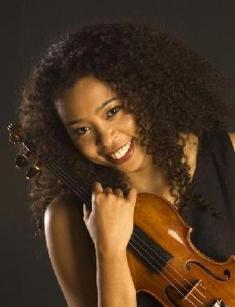
Nokuthula Ngwenyama
|
"Schubertiade." Nokuthula Ngwenyama. Arpeggione.
The words may have
needed some definition, but the musical message was clear at Sunday
afternoon's Cincinnati Chamber Orchestra concert at Memorial Hall in
Over-the-Rhine.
The event was a "Schubertiade," a concert devoted to
the music of Franz Schubert (named after the intimate gatherings held during the composer's lifetime to hear and perform his music).
Guest artist was
violist Nokuthula Ngwenyama in Schubert's 1824 "Arpeggione" Sonata in A
Minor. The arpeggione, now obsolete, was a six-stringed instrument, fretted and
tuned like a guitar, but held and bowed like a cello.
It brought a lovely
end to the CCO's two-part "Schubertiade" begun in October. CCO music
director Mischa Santora conducted.
The only work not by Schubert was
Austrian composer Hugo Wolf's 1887 "Italian Serenade" arranged for solo
viola and orchestra.
Ngwenyama, 31, is one of the new stars of the once
neglected viola. Born in Los Angeles to a Zimbabwean father and a Japanese
mother, "Thula" brought grace and refinement to Schubert's musical
stepchild. The arpeggione went out of style soon after its invention in 1823
because of its delicate tone quality and awkwardness in playing, but
Schubert's Sonata has been adopted by cellists, double bassists, guitarists
and even wind players.
It suits the viola very well. The music's soulfulness is quite
consonant with the dark-hued voice of the alto member of the violin
family. Ngwenyama (pronounced En-gwen-ya-ma) played an 1892, 15½-inch
viola by Marengo Romano Rinaldi of Turin. With it, she projected a
warm, enveloping sound that came across well in Memorial Hall's
hard-edged acoustics.
The Sonata begins with a theme very similar to the opening of
Schubert's "Unfinished" Symphony (in B Minor, written just two years
earlier in 1822). Ngwenyama impressed this gently on the ear low on the G
string before reaching into the highest register of the instrument as the work
unfolded. She spun long-breathed lines in the meditative Adagio (her audition
piece for the Curtis Institute of Music at age 16, she said) and made spirited
work of the genial finale.
Wolf's 1887 "Italian Serenade,"
originally for string quartet, later arranged for orchestra, gives a major role
to the viola. As performed by Ngwenyama and the CSO, it was a synthesis of
Wolf, the great 20th-century violist William Primrose and Santora himself, he
said in remarks to the audience. Ngwenyama put spark and sparkle in it and
there were some charming solos by principal cellist Patrick Binford.
Schubert's youthful, Mozartean Fifth Symphony will always suggest "Little
Red Riding Hood" to me because it was the background music on an LP I played
for my children when they were little. Santora and the CCO brought it all to
life again (and more) with a spirited, clean-textured performance. Red skipped
through the woods in the opening Allegro. The Andante had an autumnal air I
could envision leaves wafting to the ground in the final descending triad in the
horns. Woodwinds sang in the Trio of the third movement, and the wolf made his
dastardly appearance in the finale
Santora opened with Schubert's
Overture "In the Italian Style," D.591, one of two overtures he wrote in
response to the "Rossini craze" that struck Vienna in 1816 (Italian opera
composer Gioacchino Rossini). One of them -- which is uncertain -- was the
first work by Schubert to be played in public. D.591 (1817) is a charming piece
with occasional tongue-in-cheek humor. Schubert utilizes patter accompaniment
in the cellos and even drops in a mini-crescendo (Rossini's famed technique of
gradually increasing the dynamic level). However, it remained fully Schubertian
in its lyrical grace.
Santora and the CCO resume their 2007-08 season with
a Baroque Series in March. There will be works by Handel, Hindemith, Geminiani
and J.S. Bach (Brandenburg Concerto No. 1) March 9. The Vocal Arts Ensemble
joins the CCO March 30 for Vaughan Williams' "Serenade to Music," Bach's
Cantata No. 202 and a concert performance of Purcell's "Dido and Aeneas"
with mezzo-soprano Soon Cho (Dido) and tenor Mark Panuccio (Aeneas). Both
concerts are at Memorial Hall.
"Musical Seasons" closes the CCO season in June. Violinist Nicolas
Kendall performs Vivaldi's "The Four Seasons" and Piazzola's "The Four
Seasons of Buenos Aires" June 15 in the University of Cincinnati
College-Conservatory of Music's Corbett Auditorium. Final concert will
be June 22 in Patricia Corbett Theater at CCM, with music by Copland,
Haydn, Barber, Cincinnati composer Robert Johnson's "Three American
Landscapes" (world premiere) and selections from Gershwin's "Porgy and
Bess" with soprano Indra Thomas. For information and tickets, call
(513) 723-1182, or visit www.ccocincinnati.com.

